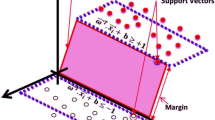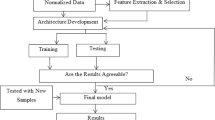Abstract
Electrocardiogram (ECG) beat classification is a significant application in computer-aided analysis and diagnosis technologies. This paper proposed a method to detect, extract informative features, and classify ECG beats utilizing real ECG signals available in the standard MIT-BIH Arrhythmia database, with 10,502 beats had been extracted from it. The present study classifies the ECG beat into six classes, normal beat (N), Left bundle branch block beat, Right bundle branch block beat, Premature ventricular contraction, atrial premature beat, and aberrated atrial premature, using Gaussian mixture and wavelets features, and by applying principal component analysis for feature set reduction. The classification process is implemented utilizing two classifier techniques, the probabilistic neural network (PNN) algorithm and Random Forest (RF) algorithm. The achieved accuracy is 99.99%, and 99.97% for PNN and RF respectively. The precision is 99.99%, and 99.98% for PNN and RF respectively. The sensitivity is 99.99%, and 99.81% for PNN and RF respectively, while the specificity is 99.97%, 99.96% for PNN and RF respectively. It has been shown that the combination of Gaussian mixtures coefficients and the wavelets features have provided a valuable information about the heart performance and can be used significantly in arrhythmia classification.














Similar content being viewed by others
References
Zadeh A, Khazaee A, Ranaee V (2010) Classification of the electrocardiogram signals using supervised classifiers and efficient features. Comput Method Progr Biomed 99(2):179–194
Yaghoobi M, Nam S, Gribonval R, Davies M (2013) Constrained overcomplete analysis operator learning for cosparse signal modelling. IEEE Trans Signal Process 61(9):2341–2355
Alqudah A (2017) An enhanced method for real-time modelling of cardiac related biosignals using Gaussian mixtures. J Med Eng Technol 41(8):600–611
Sarfraz M, Khan A, Li F (2014) Using independent component analysis to obtain feature space for reliable ECG Arrhythmia classification. In: 2014 IEEE international conference on bioinformatics and biomedicine (BIBM)
Kanaujia M, Srivastava G (2015) ECG signal decomposition using PCA and ICA. In: 2015 National Conference on Recent Advances in Electronics & Computer Engineering (RAECE)
Das M, Ari S (2014) ECG beats classification using mixture of features. Int Sch Res Not 2014:1–12
Goldberger A, Amaral L, Glass L, Hausdorff J, Ivanov P, Mark R, Mietus J, Moody G, Peng C, Stanley H (2000) PhysioBank, PhysioToolkit, and PhysioNet: components of a new research resource for complex physiologic signals. Circulation 101(23):e215–e220
Butt M, Akram U, Khan S (2015) Denoising practices for electrocardiographic (ECG) signals: a survey. In: 2015 international conference on computer, communications, and control technology (I4CT)
Afkhami RG, Azarnia G, Tinati M (2016) Cardiac arrhythmia classification using statistical and mixture modeling features of ECG signals. Pattern Recogn Lett 70:45–51
Korürek M, Doğan B (2010) ECG beat classification using particle swarm optimization and radial basis function neural network. Expert Syst Appl 37(12):7563–7569
Javadi M, Arani S, Sajedin A, Ebrahimpour R (2013) Classification of ECG arrhythmia by a modular neural network based on mixture of experts and negatively correlated learning. Biomed Signal Process Control 8(3):289–296
Güler I, Übeylı˙ E (2005) ECG beat classifier designed by combined neural network model. Pattern Recogn 38(2):199–208
Elhaj F, Salim N, Harris A, Swee T, Ahmed T (2016) Arrhythmia recognition and classification using combined linear and nonlinear features of ECG signals. Comput Method Progr Biomed 127:52–63
Dilmac S, Korurek M (2015) ECG heart beat classification method based on modified ABC algorithm. Appl Soft Comput 36:641–655
Roonizi E, Sameni R (2013) Morphological modeling of cardiac signals based on signal decomposition. Comput Biol Med 43(10):1453–1461
Arvanaghi R, Daneshvar S, Seyedarabi H, Goshvarpour A (2017) Classification of cardiac arrhythmias using arterial blood pressure based on discrete wavelet transform. Biomed Eng 29(05):1750034
Desai K, Sankhe M (2012) A real-time fetal ECG feature extraction using multiscale discrete wavelet transform. In: 2012 5th international conference on biomedical engineering and informatics
Seena V, Yomas J (2014) A review on feature extraction and denoising of ECG signal using wavelet transform. In: 2014 2nd international conference on devices, circuits and systems (ICDCS)
Kaur I, Rajni R, Marwaha A (2016) ECG signal analysis and arrhythmia detection using wavelet transform. J Inst Eng (India) Ser B 97(4):499–507
Song F, Guo Z, Mei D (2010) Feature selection using principal component analysis. In: 2010 international conference on system science, engineering design and manufacturing informatization
Mishra D, Dash R, Rath A, Acharya M (2011) Feature selection in gene expression data using principal component analysis and rough set theory. Adv Exp Med Biol 696: 91–100
Breiman L, Learning M (2001) Random forests. Mach Learn 45(1):5–32
Specht D (1990) Probabilistic neural networks. Neural Netw 3(1):109–118
Sahoo S, Mohanty M, Behera S, Sabut S (2017) ECG beat classification using empirical mode decomposition and mixture of features. J Med Eng Technol 41(8):652–661
Homaeinezhad M, Atyabi S, Tavakkoli E, Toosi H, Ghaffari A, Ebrahimpour R (2012) ECG arrhythmia recognition via a neuro-SVM–KNN hybrid classifier with virtual QRS image-based geometrical features. Expert Syst Appl 39(2):2047–2058
Llamedo M, Martínez J (2011) Heartbeat classification using feature selection driven by database generalization criteria. IEEE Trans Biomed Eng 58(3):616–625
Dutta S, Chatterjee A, Munshi S (2011) Identification of ECG beats from cross-spectrum information aided learning vector quantization. Measurement, 44(10):2020–2027
Qin Q, Li J, Zhang L, Yue Y, Liu C (2017) Combining low-dimensional wavelet features and support vector machine for arrhythmia beat classification. Sci Rep 7(1):6067
Shadmand S, Mashoufi B (2016) A new personalized ECG signal classification algorithm using block-based neural network and particle swarm optimization. Biomed Signal Process Control 25:12–23
Banerjee S, Mitra M (2013) ECG beat classification based on discrete wavelet transformation and nearest neighbour classifier. J Med Eng Technol 37(4):264–272
Author information
Authors and Affiliations
Corresponding author
Ethics declarations
Conflict of interest
The authors declare that they have no conflict of interest. This research did not receive any specific grant from funding agencies in the public, commercial, or not-for-profit sectors.
Additional information
Publisher’s Note
Springer Nature remains neutral with regard to jurisdictional claims in published maps and institutional affiliations.
Rights and permissions
About this article
Cite this article
Alqudah, A.M., Albadarneh, A., Abu-Qasmieh, I. et al. Developing of robust and high accurate ECG beat classification by combining Gaussian mixtures and wavelets features. Australas Phys Eng Sci Med 42, 149–157 (2019). https://doi.org/10.1007/s13246-019-00722-z
Received:
Accepted:
Published:
Issue Date:
DOI: https://doi.org/10.1007/s13246-019-00722-z




